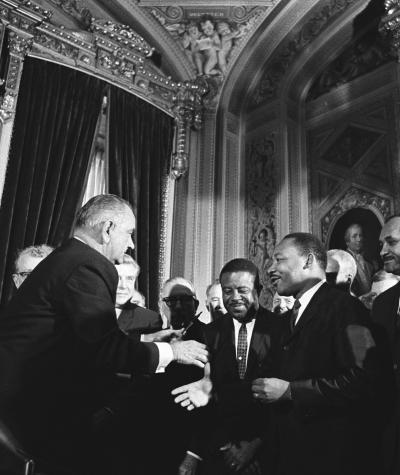In 1965, Congress passed a bill that would change the course of this country’s history and the shape of our democracy forever. That bill was the Voting Rights Act, or the VRA. For almost 50 years, the VRA protected the political voices of voters of color and ensured all voters could participate in the democratic system. Those protections, though, have been severely weakened since the Supreme Court’s decision in Shelby County v. Holder in 2013.
The U.S. House of Representatives has now passed a bill that would remedy this problem and honor the legacy of the VRA—so how did we get here?
A History of Discriminatory Voting Practices
Before the passage of the VRA, the path to desegregating democracy had been slow. As soon as advocates identified and combatted one discriminatory practice, another would emerge in its place – so poll taxes and white-only primaries might be replaced by literacy tests or racial gerrymandering. Justice Ruth Bader Ginsburg powerfully described this history saying, “[A]ttempts to cope with this vile infection resembled battling the Hydra. Whenever one form of voting discrimination was identified and prohibited, others sprang up in its place.”
A piecemeal approach to combating racism in our democracy was not working. The solution: the VRA.
Combatting Race Discrimination Under the VRA
The VRA sought to solve this problem by embracing a unique structure. It not only provided a private right of action so voters of color could sue to challenge discriminatory practices as they arose, but also created a system of “preclearance” that forced jurisdictions with a history of repeated race discrimination to submit changes to their elections for review, thereby identifying discriminatory practices before they could be implemented and preventing disenfranchisement before it could occur.
Preclearance was revolutionary, preventing states and localities that were proven bad-actors from moving forward with new, creative ways to discriminate against and disenfranchise voters of color.
This system worked, and it worked well. In the seven states originally subject to preclearance, the number of registered Black voters ballooned from less than a million in 1965 to nearly 3.6 million in 1986. Voters of color could not only increasingly participate in elections, they could elect their candidates of choice, which in turn created new pathways for candidates of color to serve in state and federal elected office across the country. The VRA not only gave individual voters of color a vote, it gave their community voice – it gave them real political power.
The VRA and its preclearance system is widely recognized as one of the most effective civil rights measures ever passed into law. It was reauthorized five times with overwhelming bipartisan support, most recently in 2006 by a vote of 390-33 in the House and 98-0 in the Senate. During each re-authorization, Congress held hours of hearings that demonstrated the persistence of racism in our democracy and the continued effectiveness of the VRA in combatting it.
Shelby County and the Loss of Protections Under the VRA
In 2013 the U.S. Supreme Court put an end to this progress when it handed down a decision in Shelby County v. Holder. That decision gutted the VRA by invalidating the formula it used to determine which jurisdictions should be subject to preclearance. Despite the detailed record demonstrating the persistence of efforts to disenfranchise voters of color, the Chief Justice and majority on the Court found that the preclearance formula was no longer necessary.
The result has been disastrous, leaving voters of color without robust protections to prevent discrimination in elections. In the year before Shelby, the Department of Justice received 18,146 submissions of voting changes for preclearance; in the six years since, the nine states and dozens of counties and towns with histories of discrimination that had been formerly covered by preclearance have been able to impose tens of thousands of burdensome election rules without any oversight.
The chief justice did, however, leave the door open for a fix. He tasked Congress with passing a new, updated formula to determine which jurisdictions should be subject to preclearance requirements.
Restoring the Protections of the VRA
The House took an important first step through that door when it passed the Voting Rights Advancement Act of 2019 or H.R. 4, a bill offering a new preclearance formula to restore the VRA. CLC joined a coalition of organizations calling for the passage of H.R. 4 in a letter to Congress. H.R. 4’s preclearance formula is narrowly tailored, only imposing oversight on jurisdictions that have been shown to have discriminated against voters of color between 10-15 times in the last 20 years.
The Senate, now, must take action and pass the Voting Rights Advancement Act of 2019. Until they do, voters who have been living in these jurisdictions – who have been subjected to ten or more discriminatory laws over the last two decades – will be left without protection and at risk of disenfranchisement.
